Chapter Twenty
Finding God in a Cave
Robert’s search for his guru took him across the seas on a merchant vessel to India and by train to South India where he caught a ferry to Ceylon, arriving in Colombo in March of 1947. As arranged by Grace Burroughs, he studied with Dayananda Priyadasi, a Sinhalese Buddhist teacher of meditation and occultism who had visited the US in the mid-1930s and captivated seekers there. §
Dayananda proved a challenging teacher who confronted the young American with an onslaught of new ideas and personal ordeals. In the process, Robert learned the art of getting positive things done in the world, and he learned how demanding a spiritual teacher can be. The young seeker completed each assignment given him by his new catalyst, no matter how difficult. Within months of his arrival, he helped found two schools for village children, assisted in reviving the dormant Kandyan dance and introduced the use of power saws to carpenters, while still finding time to tour the island performing with his dance troupe. §
He was thrilled to be in a new land, with all of the discoveries and surprises that brings. He loved the people, admiring their humility and hospitable ways, learning from their subtle cultural instincts. But after two years, all of this activity—and especially the never-ending litany of projects and demands presented by Dayananda, many of them political—was beginning to weigh on him. He was eager to help his teacher, eager to fulfill his cultural mission, but never forgot his real purpose in coming to Ceylon: to realize God. He had always wanted to undertake serious sadhana in a cave, and this desire loomed ever stronger in his mind.§

During the four-week voyage, the cultural troupe practiced on the ship’s wooden deck and Robert enjoyed the first real solitude of his life. They disembarked in Bombay.
• • • • • • • • • • • • • • • • • • • • • • • •§
One day my training was completed. My teacher, Dayananda, flew off to attend a religious conference in Switzerland. I was alone in Ceylon. I thought about the cave again. One of my close Muslim friends, Anbakara, who had Hanuman as his mentor, took me to the caves of Jailani, Kuragala, Balangoda, secluded caves naturally carved in solid rock in a mountainous valley deep in the central jungles of the island. There I met my fifth catalyst on the path of enlightenment. His name was Mustan.§
The Jailani Caves are 150 kilometers southeast of Colombo, in the remote jungles. It is to this day a holy site, and a gathering place for Sufi mystics. The journey of several days wended through the nearly uninhabited central hills of Ceylon, with its tiny villages and dusty roads. Robert saw elephants bathing in the rivers and pulling logs on massive chains out of the forests. It must have seemed a wonderland to the American, a Shangri-La. One thing was for certain, it was far from the life he had been so actively immersed in. It was the refuge he had longed for.§
Up the hill Robert and Anbakara walked to the mouth of the rock caves overlooking the Kaltota Plains. What they encountered is described by R.H. Bassett in Romantic Ceylon, Its History, Legend and Story, published in 1929:§
The cave itself is a most interesting place. It is entirely natural, bearing no signs of artificial excavations or of ritual adornment. The entrance is situated in the face of a cliff a short climb down from the summit where on entering there is a large “hall” from which two passages lead off on either hand. The right hand passage is seen to extend for at least 50 yards into the depths of the Earth before merging into the general darkness of the shadows.§
On the opposite side of the entrance hall, a narrow passage leads out on to the meditation “ledge,” a niche in the sheer side of the cliff, some 6 foot by 4 foot with an overhanging roof of rock. Here seated beneath a huge mass that towers fifty feet above on the edge of a 600-foot precipice, a hermit can find solitude indeed and food for contemplation in the unbroken ocean of trees spread out below him. Entering from a small hole in the rock, at the back an atmosphere of complete detachment pervades the occupant of the tiny ledge. Earthly considerations lose their importance before the uncomplicated immensity of the colossal landscape and the fatality of the sheer abyss.§
Robert was home. He was here to meditate until he realized the Self. But his mind wandered to his lifelong ambitions for improving conditions in the world by the power of spirit. World War II had just ended, and he had the highest of hopes of a peaceful new age for humanity, as expressed in a letter dated December 28, 1948:§
Remember the day when evil forces held sway and how we did pray to pen the way for Freedom of Nations through World Federation by building this Nation in a cooperative way?§
Evil forces are gone, we continue, March on and lead all these Nations into the net of Universal Love for the masses irrespective of classes, and release all from bondage, strife into new Life.§
The Lord is on Earth in a practical way; a new system of finance does now hold sway. Come on ye nations, Awaken today. Awake, alive all beings united, the Life spark in man the Lord has ignited.§
The Light shines so bright seven years from tonight. His Mission is ended, organizations complete, the world now lies at his feet. All look to Ceylon which now leads the way, a spiritual country in a practical way.§
Freedom for Nations is well on its way, now He’ll adjust. The Lords Will holds sway. The spirit has risen, the Gods do obey. Their channels are ready, to Earth do they come. The AUM is heard in a vibrant Hum.§
Souls reach perfection without delay. The last war has ended; TRUTH’S power has mended all hearts bound in war, and has made all beings pure like snow. The path clear, THE NEW AGE IS NOW HERE. §
Jailani Caves§

In a cave deep in southern Ceylon, Robert fasted and meditated, ultimately realizing the Self beyond time, form and cause. One day a python slithered across his lap, but he was so deep within he neither saw nor felt it.
• • • • • • • • • • • • • • • • • • • • • • • •§
In a second letter to America, written from his aerie, Robert wrote of his aspirations: §
Off in the Jungle, so dear to my heart.
I Darn’t rest for a Moment, since we’ve given the start,
To New Age Movements held long
By one who is strong.
He had others to help
All turned Tail with a Yelp.
I must develop more Will, and give these Movements a Push
Sitting so still, Eyes turned in and up.
I command forth Will enough to fill and make the Universe
Quake and Shake, then Remain very still.
Alone on a hill developing will,
So as to fill and thrill
Leaders to be in Lands O’re sea.
With Power so Great, Love so Grand.
That they’ll spread these Movements throughout their Land.
Their Founder is strong. The Complete Master of Life.
He knows how to Live. To give is to live.
So he gives of Himself, a World to Create, an Order to
Bring forth, that will Banish all Hate.§
L’AMOUR UNIVERSAL IS THE WORLD’S FATE.
Bob AT JALANY CAVES ON RETREAT
for Ed. Munger, Esq., Jan. 9, 1949§
Another mystic was living at Jailani, a wonderful Muslim called Mustan. Decades later, in relating the story to his monastics, he recounted:§
They say Mustan never took a bath, but he smelled as sweet as a flower. He was so old; he was so pure. We had a wonderful meeting. When he saw me he said, “I had a dream about you.” Then Mustan pulled a little notebook out of his pocket. He said, “I wrote it down here where I write down all of my dreams.” I said to him, through my friend who translated from Arabic into English, “I had a dream about you, too,” which I had just a few nights before. I had written it down also. I had been trained at that time to write down all my dreams. He said, “My dream was during the last full moon.” We compared dates. We had both written down the same dream at the same time about our meeting together on the inner planes at night while we slept.§
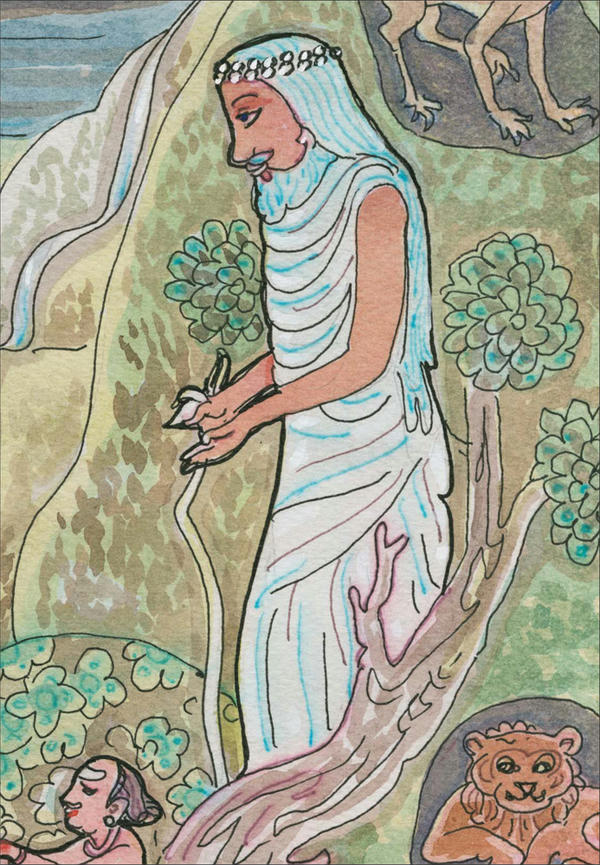
Mustan, a mystic living near Jailani, seeing the seriousness of the American seeker, meditated with him and offered rare instruction about dreams and the third eye.
• • • • • • • • • • • • • • • • • • • • • • • •§
He began giving to me a profound training centered on the conscious use of the third eye. He explained and projected with his mind force the intricate capabilities, development and unfoldment of the faculties of this chakra. Mustan lived in a small cave with a little door on it. One had to walk many steps up the side of a hill to get to it. I lived in a nearby mosque at the foot of the path to his cave.§
At night he took me out and meditated with me on wind-swept hills where yogis used to meditate hundreds of years ago. He made me sit perfectly straight for hours at a time. The wind was blowing hard against my body. It was cold. There, in the dead of night, he would say through my translator, “Did you see this? Did you see that? Are you seeing what I’m seeing?” He was revealing a form of mysticism taught in the Koran. He shared all of this with me. I learned some extremely intricate workings of the third eye and the psychic unfoldment of it through the faculties of the soul. This knowledge has become an extremely useful tool in my work today. I really appreciate my fifth catalyst on the path, Mustan.§
He was an old, old soul, a rare being living a dynamic, spiritual life in that remote jungle. A Muslim saint named Abdul Qadir Jailani lived in the caves of Jailani, meditated and had a school of mysticism, hundreds of years ago. These caves were on top of a mountain about a mile from where we lived in the mosque. When penetrating deep into the cave, one can see light in the crevice deep in the center of the mountain. In the mysticism of Islam, this is thought to be a direct route to the inner planes, to Mecca. §
The caves themselves are situated on a cliff that drops six hundred feet to a tropical jungle below, where wild elephants are often seen. I was taken there by my friend for a series of meditations. As I walked up the rugged dirt path, I realized that this was the cave in which I would one day realize the Self. For no particular reason, I felt it could be done here. It would be done here. That’s how it is before you realize, you think there is something to do or something to get or become.§
We stayed for a few days together, my friend, Anbakara, and I, sleeping on the stones just outside the cave, since they stayed warm during the night. We meditated long hours, silently penetrating deep into the mind. It was so quiet there. He told me one afternoon that as I sat above the valley in the lotus posture I always use, a large python had crawled over my legs, across my lap and back into the rocks. As the days passed I felt more and more blissful, drawn to the absolute center of myself, as if by a powerful magnet.§
One morning I awoke and sensed we should leave the caves, that I should return alone to take the final steps. We returned to Colombo, where I completed several tasks for my former teacher, which inwardly freed me. When they were done, I returned by myself to the caves of Jailani. On the way back, I was determined. I vowed not to quit until I had the ultimate unfoldment of this lifetime. I had received outstanding training along the path up to this point. I had learned many things. Always the desire for the realization of the Self, im kaif, was paramount in my mind.§
I was told by my teachers along the way that I had to get the foundation and the understanding of the various inner and outer areas of the mind in order to have strength enough to sustain the reaction to the realization of the Self. Each catalyst up to this point had helped me and introduced me in one way or another to my next teacher. This was not planned. I did not look for another teacher. I expected each teacher to be my last one. In fact, I didn’t even think about it. Our meetings all happened in an easy, natural sequence of events.§
Each teacher had his part in developing the memory faculties, one-pointedness, concentration, stimulating the meditation faculties, the willpower and the cognitive faculties—teaching me to see everything from an inner perspective and looking at the world as if one were the center of the universe.§
There was just one thing lacking, however—and I had to find that myself—the ultimate goal, realization of the Self, God. It was with joy and a burning desire that I walked the ten or twelve miles from the nearest road to the caves of Jailani. I had absolutely no possessions with me. I had given all of my clothing away. I had given all of my money to the villagers along the road. I had nothing. I just went there to be alone.§
I took no food, again vowing to myself, “I am going to fast until I find this realization that I so want and have wanted for such a long time. Now is the time.” When I arrived late that afternoon, Mustan wasn’t there. He had gone away on a pilgrimage. No one was there. There were no pilgrims. I was alone. I walked up and into the cave and began to fast and meditate. I went in and in and in and in and then in and in again, and finally I went in and in until awareness became totally aware of itself, kaif, and into the control of the breath until the breath breathed no more, and then in from kaif to ii kaif—the most intense possible kaif experience wherein the brink of the absolute is felt—and then into the Self, Parasiva. §
I came out again into the mind. Villagers had seen me on the cliffs from six hundred feet below. They thought I was some sort of holy man and brought food and drinks, all sorts of nice things. We had a big feast. I was hungry. They had come all the way up from the valley. They were so kind.§
After several weeks, I returned to Colombo, the capital of Sri Lanka, a hundred miles away, with a Muslim man who also had come on a pilgrimage from a foreign country. He taught me a wonderful Islamic chant along the way. I never saw Mustan again. He taught me everything I needed to know to complete my training for the realization of the Self during my first series of meetings with him. It was intense. It was strong.§
These mystics also connected Robert to inner-plane beings, especially a particular genie who worked with him to assist in his mission throughout his life, guiding potential disciples to the guru and often finding things that had been misplaced. §
Discovering Hindu Temples
Still immersed in the radiant aftermath of his cave revelations, Robert took to the trail that led back to civilization, back to the capital of Colombo, back to another and lesser reality. This time he settled into the local YMCA, where he got a job teaching hatha yoga to pay for his room. He was between worlds. Freed from Dayananda and no longer obliged to the dancing mission which had split up, he began a new exploration which led him to the temples of the city.§
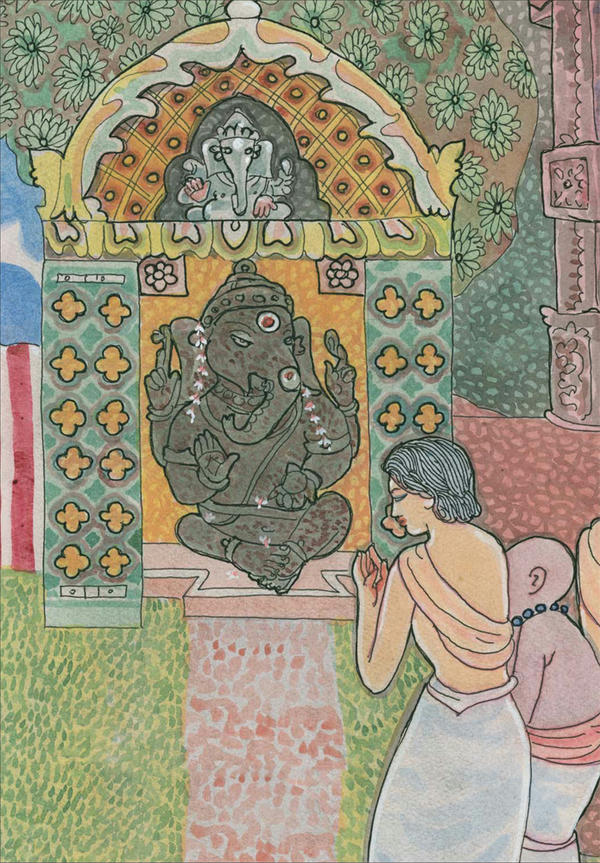
Kandiah Chettiar befriended the American, taking him to the small, traditional temples in Colombo, where Robert discovered Lord Ganesha and other Gods of Hinduism. The two moved through the city like old friends.
• • • • • • • • • • • • • • • • • • • • • • • •§
Back in the city, nothing looked the same anymore. I was in another dimension. Everything was different. I had lost something: the desire for the realization of the Self. I felt complete. I felt alone. I spent several weeks in Colombo absorbing the darshan, the impact, of the cave experience. It was too vast to be understood, to be grasped by the intellect, so I enjoyed knowing that I knew something I could never adequately explain. §
One night, just before sleep, I saw before me a vision of a tremendous peacock tail. It was fanned open in vivid colors, framing the screen before my eyes. In Hindu mysticism, Lord Murugan rides on a peacock through the akasha, the inner plane of consciousness inhabited by beings of very refined vibration. This is the way He travels in the inner area of mind.§
In the Pettah district of Colombo, a Hindu enclave, Robert was drawn particularly to a Ganesha temple, a small, thoroughly traditional temple which had seen few outsiders within its walls. But within those walls Robert discovered an inner world hitherto unknown, even unimagined. It captured him instantly, and he began to visit daily.§
The day after his vision of the peacock, Robert met Kandiah Chettiar, a businessman and English teacher from Ceylon’s far north, where most of the island’s Hindu community lived. Kandiah Chettiar was the quintessential Tamil—highly educated, English-speaking, spiritually awakened and philosophically astute. A man of 5' 8", he had a ramrod spine, and when he sat for meditation, it was as though he had turned to stone, the result of his years of discipline under Chellachi Ammaiyar. His encounter with the American mystic, newly arrived from the Great Beyond, was more than coincidental. Some thought that Yogaswami had sent him to fetch Robert, but there is no proof of that.§
The next morning I met the sixth catalyst on the path, my next profound teacher, Kandiah Chettiar. He was a dark-skinned and broadly built Tamil man from the northern peninsula of the island. He was to take me to my guru, but I needed preparation first. He gave it to me. He took me deep into Hinduism. §
Up to this point I had studied yoga and had a fine exposure to Buddhism in Sri Lanka, but had not been made aware of orthodox Hinduism. He brought me into Hinduism from a deep, inner-plane perspective, teaching me the mysticism and then the ritual. I began meeting the Hindu Gods, the Deities, inside the inner areas of the superconscious mind, and learned how to relate to them. They were kind to me. Chettiar patiently taught me all of the esoterics on Hinduism.§
The two bonded at their first meeting, the towering foreign youth and the traditional local elder—each seeing himself in the other, each admiring the other’s gifts. They formed a lasting friendship from the start. As much on his own inspiration as by Robert’s insatiable curiosity, Kandiah set about instructing him in the esoterics and customs of temple worship as well as many of the occult laws at work within the rituals. Robert would later recount:§
For the first time, I experienced how Saivites worship the Gods, about puja and the priests, about the mysteries of the temple and their connection to the inner worlds. Now the pattern was complete. I had been taken into the Tamil Hindu community and was preparing myself to formally enter Hinduism when the timing was auspicious.§
Somewhere in those first weeks of their friendship, which would span their lives, Robert began to intimate that he would like to be introduced to “a very pure priest,’’ someone who could take him into the Saivite Hindu religion. Kandiah Chettiar knew well what he meant, but repeatedly dismissed the idea, knowing in his heart that the day would come if all was handled perfectly. §
The two began to explore the temples in and around Colombo. Unlike most temple-goers, they explored the inner workings of the temple, and Kandiah instructed his charge in the inner and outer workings of their worship. Robert had awakened a sensitivity to spiritual vibrations, to the inner energies that are the essence of a Hindu temple, and he was driven to understand them, to know how they were generated by the priests, how they impacted the worshippers, what was their source. Kandiah Chettiar wrote: §
The young man was observed to be a man of character and ability to understand men and matters quickly and easily and was observed to be at some concentrated thought, though he was a member of many activities, such as the World Fellowship of Youth, World Fellowship of Artistes, Fellowship of Mothers and a host of other activities. His motto was “Art survives not by Mammon’s Mammoth gold, not by titanic times’ pyramidal remains, nor by ivory dreamers’ gossamer tapestries, but only by the presence of the passionate votary at the altar of art’s everlasting soul, from age to age.” §
Every activity that he initiated progressed, but he had no attachment towards it and was often expressing that it was a duty to set it moving. A sort of non-attachment, like water on a lotus leaf, was seen in all that he did and spoke.§
The Hindu temples of Sri Lanka are small by Indian standards. There, the major temples are the size of a small town, with 12-foot-high walls surrounding dozens of large shrines and smaller temples. But what Sri Lanka’s temples lack in size, they more than make up for in purity and power. Pujas here are notoriously on time, and the entire space is clean beyond imagination. There is a sense of closeness and shared community, partly due to the presence of the majority Buddhists, a presence which was not always friendly and which therefore tied the Tamils together for self-preservation. The temples reflected that unity in an unusually stringent discipline and adherence to well-defined rules, including dress codes. Women would never enter during their periods, and non-Hindus were kept away. Men would never enter a temple except in their traditional wrap, the veshti. Robert followed this most carefully. He knew his towering size and white skin made him the center of attention, and he wanted to prove himself to the people he was learning to love. §
Robert had been to the Buddhist monasteries and stupas throughout the land, but it was the temples of Hinduism that captured him. Their profound spirituality, made alive by Sanskrit chanting and rituals that went back to the dawn of human history, moved him deeply. For the first time in his life, within these holy chambers he saw true devotion, for the Tamil people are profoundly devotional. Worship in the West is a shallow thing by comparison. Here crowds move as one, and festivals are giant, complex affairs that engage every man, woman and child in the area. Devotion is not restrained, but let free, with tens of thousands of bhaktas singing together, moving from shrine to shrine and suddenly shouting “Haro Hara!” in a one voice that shakes the stones. Robert was enchanted, and eager to know more. His teacher observed:§
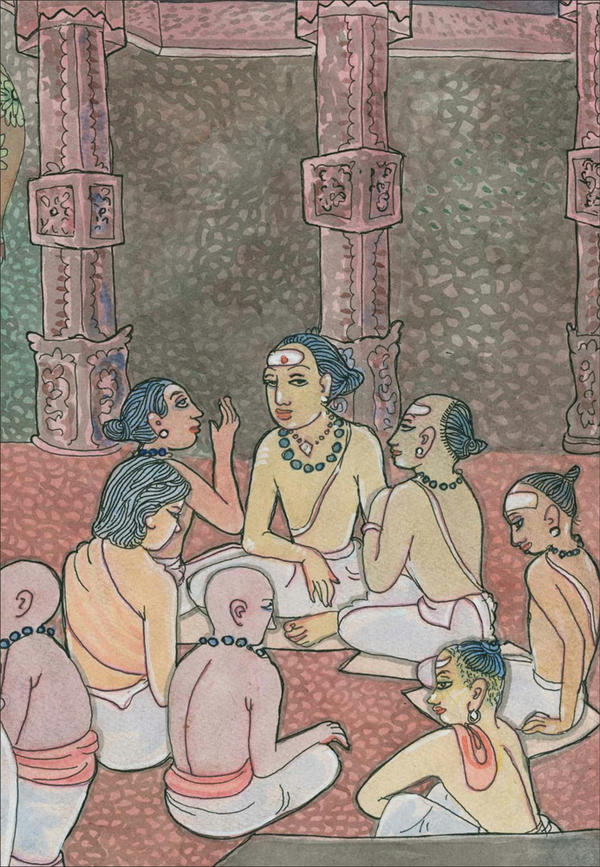
When he wanted to attend the temple regularly, Robert was called before a council of Saivite elders and interviewed in detail about his intentions and his understanding of Hinduism. After assessing his sincerity, they allowed him to come freely.
• • • • • • • • • • • • • • • • • • • • • • • •§
On hearing that the religious rites done in temples are so important and create a devotion towards the Supreme Being, at first he wanted as a matter of curiosity to pay visits to the temples; and when once he started doing so, he felt a mental happiness and ease that he was so highly pleased to pay regular visits to the temples. Here he was observed to be forgetting himself from the normal state of mind and enjoying a sort of trance and calmness in the presence of images like Ganesha, Siva, Goddess Uma and Subramaniya. Though he was not aware of the holy days according to the Hindu calendar, he was asking whether a certain day was a spiritual day for Lord Ganesha. It was exactly correct.§
Temples in Ceylon were not accustomed to Western visitors. For the most part, the British and others looked down on Hinduism and Buddhism, and kept a distance from the sacred sites. The young American’s interest was welcomed, but it was also perplexing. The elders who oversaw the temple’s affairs had observed the frequent visits by the Tamil Saivite and his charge. One day, they called Robert into their midst. Meeting for over an hour, they carefully interrogated him, inquiring into the nature of his interest and the depth of his knowledge. He was dismissed, as they discussed what to do. §
A message was sent out to Kandiah Chettiar that Robert would be welcomed anytime into the temple. This careful scrutiny informed Robert of the privilege of his visits, and of the close security the community kept within the temples. He knew it was their way of protecting the sanctity, and in later years he would be similarly cautious with his own temples. Decades later he shared:§
My sixth catalyst introduced me to the esoteric worship done within the Hindu temple. He told me why they ring the bells and blow the horns and beat the drums. He explained intricately the role of the priests and what they do, why they wear the holy ash, called vibhuti, on their forehead, arms and chest. All the whys and hows were explained to me. I saw it all from an inner perspective. I loved the temples. This experience brought the Gods to life in my mind, and we were like father and son. So we went everywhere together.§
I became so sensitive to the vibratory rate of the astrological configurations of stars and the power that they effected upon the Earth during certain times of the year that I was able to tell my catalyst exactly what Hindu Deity would be worshiped at a temple and the very day that particular service would be conducted. I would tell him, “Come on, we have to go quickly to the temple. Lord Ganesha is being worshiped today.”§
My catalyst was amazed and enthralled that, without the calendar used exclusively by the priests, I could sense the vibration of the day accurately, thus proving that the old calendars establishing temple worship of the many Hindu Deities were superconsciously calculated thousands of years ago.§
These are certain faculties one finds within himself. They are within every human being. I merely learned to use them, to be sensitive to what is already there. It came so easily. My experience at the caves of Jailani began to grow within me after subsequent experiences of the same type.§
We, the catalyst and I, spent our time in conversation, meditation and traveling from temple to temple as he revealed to me the pure mysticism of Hinduism that one does not find in any books, for it is passed on from father to son, from teacher to disciple.§
Elephant Pass
Robert had lived his whole life hearing of yogis and their magical powers, of Vedanta and its intellectual prowess. And he had spent the past two years among the Buddhists, for whom there is no Supreme Being, no God as such. While the Buddhist and Vedantin ideals of transcendence touched his deepest soul, there was in them little of the divine love, supreme devotion and sense of oneness with God as a real and present being, a feeling the temples and the Tamil people exuded without cessation. This combination seemed right to him, seemed a more complete concept of the sacred universe, one that his own meditations had revealed. The Saiva saints spoke a language he understood, though he had seldom heard it. The concept of God elucidated in Saiva Siddhanta—as the Supreme Being, who is immanent in His creation and yet transcends all time, form and space—mirrored Robert’s deepest intuitions. He had found this completeness nowhere else and recognized Saiva Siddhanta as “the religion of my soul.”§
I was happy to find a complete culture that accepted the monistic advaita of Vedanta and yet cherished and practiced the many other dimensions of life, celebrated festivals, valued the great yoga called bhakti, honored those who performed sadhanas, understood the way of kundalini yoga, knew the mysteries of penance, including rolling around the temple in the hot noonday sun, and lost itself—or should I say found itself?—in the chambers of the hallowed temples where darshan was sought out and the Gods were seen and felt as real beings when invoked by the magical priests to enter the temple at the height of the ceremony.§
Each day the urge grew in Robert to go to the North. He knew the Tamils of Colombo were a tiny minority, and that the fullness of their culture was expressed only in the North, where their numbers were greater. So many stories were told of Jaffna, of its noble history, its rich culture and spiritual pride, its holy men and women. He begged Kandiah Chettiar to take him home. Chettiar later wrote:§
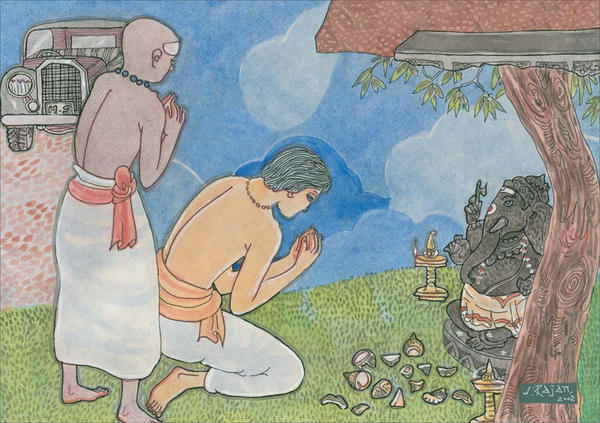
Finally, Kandiah Chettiar drove Robert from Colombo to his home in the North. They stopped at Elephant Pass, where Saivites worship Lord Ganesha under a tree. This is considered the spiritual gateway to Jaffna, the stronghold of Ceylon’s Tamil Saivite community.
• • • • • • • • • • • • • • • • • • • • • • • •§
The intimacy between us was so deep, sincere and true that we became two in one. His desire to go to Jaffna, my homeland, where the original ashram was started, was so great that I had to consent to his decision to go to Jaffna. He felt that he must be in my homeland once at least and I agreed for two reasons. One, to satisfy his desire, and two, to make him to meet a soul whom I love and regard and call “a speaking God.” §
The real start of religious life begins by meeting a yogi, who imparts the seed of holiness by a look, touch or word. In speaking about the greatness of this highly advanced soul, I used to describe him to my friend, now Sri Subramuniya, as the “Yogaswami,” only “a typical beggar.” Though this statement was made to Sri Subramuniya at a distance of 250 miles, the advanced soul, jnani, on the first day of meeting, addressed himself a “typical beggar.”§
Chettiar was wise, and did not press the visit to the North. Instead, he continued to regale Robert with tales of Tirumular and Tiruvalluvar, ancient Tamil poets and yogis, and to intimate not infrequently how special it would be, how incredibly blessed it would be, for them to enter, one day, no hurry, Yogaswami’s mud hut.§
Very carefully my teacher began telling me about a “madman” in the area, a guru who was so powerful, so unpredictable, that people were afraid of him. He explained the nature of this man and how he had been the only disciple of the great Chellappaswami. I was told of his work in the Jaffna area. Carefully, my teacher described how one approaches such a being and how he attained Self Realization at forty years of age and ran for twenty miles on the power of it, he had worked for it for so long. He was so happy that he had finally achieved this great goal at forty years of age. I would be patient, and the subject would always come around to the guru of the area, Yogaswami. In this way, I learned of him and of his teaching. One day, my teacher invited me to his home on the Jaffna Peninsula in the North of Sri Lanka.§
One day, when Chettiar sensed the time had come, the two embarked on the 250-mile cross-country journey, on unimproved roads through the Kandy highlands and then down into the arid northern plains to a place called Elephant Pass. All Hindus stop here, for it is regarded as the passageway into the Saivite peninsula. There is a small Ganesha shrine there, under a tree, where devotees light camphor on a coconut and then break it on the ground to beseech blessings from the Lord of Dharma before proceeding on the narrow, 3,000-foot-long isthmus that connects Jaffna to the mainland. §
They stopped the car and worshiped Lord Ganesha. While meditating there, Robert inwardly saw a flame on top of his head. It appeared spontaneously to his inner sight and persisted for three or four days. Robert would forever feel that this was his formal entrance into the Saivite world. The name Elephant Pass was permanently etched in his memory.§
At a Lord Skanda temple, Robert mystically absorbed a sacred form of dance, performed by Lord Nataraja, during a powerful darshan before the Nataraja Deity. In a profound vision, he saw Siva as the Cosmic Dancer animating all existence. It transformed him. What was unfolded to him in those sacred moments was a technique that employs a specific combination of 49 movements of feet and legs and 49 movements of hands and arms and 49 movements of head and eyes, shoulders, torso and body, in sequences of seven. The dance was a tool for throwing the shakti into distant places, as did Murugan aim and throw His vel. This was the purpose of this dance, which began on the rhythm, “tye-ya tye-ya tye-ya ta—tye-taka tye-ya tye-ya ta.”§
As they left the temple that day, Kandiah Chettiar remarked, “You will never be the same after this.’’ He remembered these days in a letter to America:§
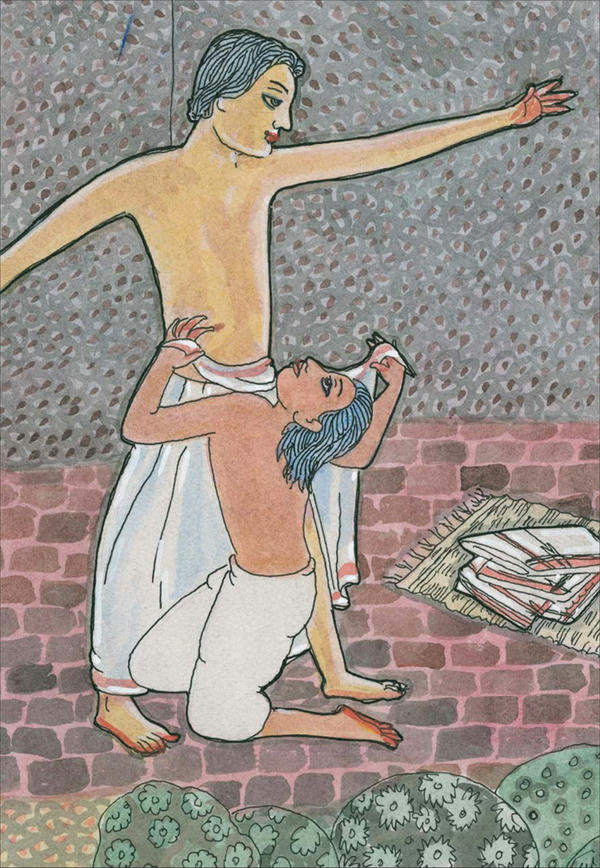
For several weeks Robert lived with the Chettiar family, discovering their traditional lifestyle, being overwhelmed with their hospitality and learning the finer points of wrapping a cotton veshti, which all Hindu men there wear.
• • • • • • • • • • • • • • • • • • • • • • • •§
The pleasure he took in standing before the images decked with gold and brilliants, which were more in the form of transmitters of power and knowledge, jnana, was highly appreciated and enjoyed by the young man. The priests in the temples were so highly taken up by the true devotion of a Westerner, with such a princely appearance, that they began performing pujas with special attention. I well remember a day, a Tirukarttikai Day, when my dear friend [then] stood before the golden statue of Lord Muruga (Subrahmanya) decked with brilliants and garlands, in a posture which I can never forget. Tears gathered in his eyes and he was in a trance with his hands bowing with an expression that you (God) and I are one. It appears that a theoretical start of initiation has been started on this particular day.§
Adopted by a Hindu Family
It was morning when the car pulled up in front of Kandiah’s home in the village of Alaveddy. Seeing Kandiah with the unexpectedly tall Western guest, Kandiah’s wife and son and daughter-in-law didn’t know what to do. Their dwelling was humble—two small, adjacent houses made of earth and cadjan. As traditional villagers, they lived close to the earth, growing much of their own food, grinding their own flour and drawing their water from a simple well. They were struck by Hansen’s presence; they had never seen anyone so tall, and they had never entertained a Westerner in their home before. Quickly, though, they were set at ease by his grace and simplicity. Kandiah Chettiar described the relationship:§
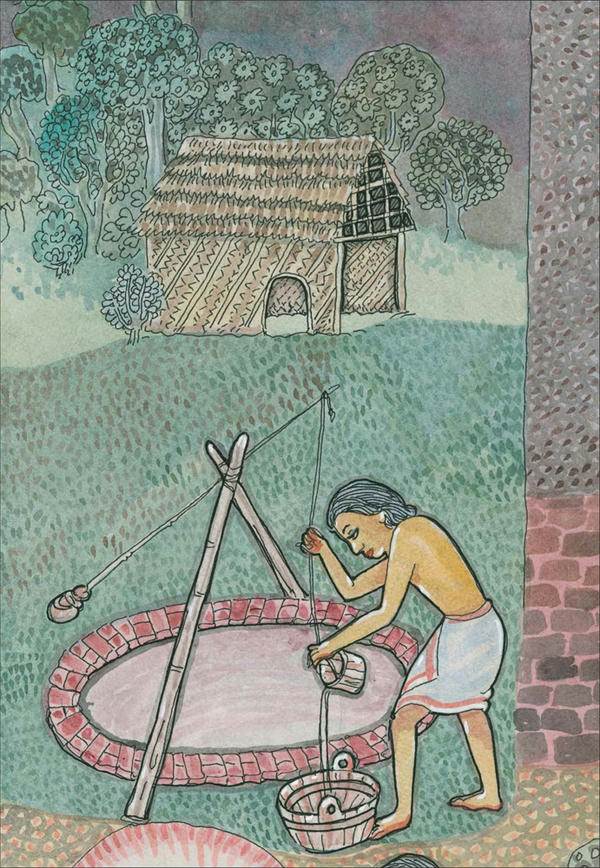
When he sought more seclusion, the family took him to a nearby thatched hut they owned amid the brambles. Here he could meditate far into the night, freed from the bustle of village life, bathing at his own private well.
• • • • • • • • • • • • • • • • • • • • • • • •§
Our trip from Colombo to Jaffna was in a car, a new, comfortable Austin 12, and the whole journey was a happy one, because we visited a good number of ancient Hindu temples and were able to have concentrated religious practices. §
We arrived at our home, a humble mud house, at 5:30 in the morning, and the young man was introduced to the members of my family. The visitor felt himself quite at home. Food preparations in an Oriental style were served to him. He very much liked the mangoes in our grove and the jak fruits which we had in abundance. §
He loved me and the members of my family and started calling my wife “Mother Chettiar.” The beauty in the love that existed between the mother and child was only expressed by kind smiles and looks, as he did not know Tamil nor she English. His expression of love and gratitude in all letters that he wrote from USA and her hearing it with pride and pleasure is worthy of comment.§
Kandiah’s son had just married, and his bride of just eighteen years had moved into his family’s home. Decades later, Mrs. Sivayogam Vinayagamoorthy—that new bride—spoke of those days: §
When my father-in-law—who was staying with Robert at the Colombo YMCA and was impressed with his steady morning devotions—wrote home to inform the family that he would be bringing a young American to our home, all were horrified. The home was too humble. To prepare for the guest, we decided that the family would move out of the house and give it entirely to Robert for his stay. §
Upon his arrival we were astonished to see his great height. He was so tall he couldn’t stand upright except in the very center of the house! After some hours, he was very close with us—like a brother to my husband. That evening my father-in-law took him to the Ganesha Temple. The priest asked his name, and my father-in-law said, “Thamby. We just call him Thamby [‘young one’].” He made everyone so comfortable, like part of the family; we all stayed in the house.§
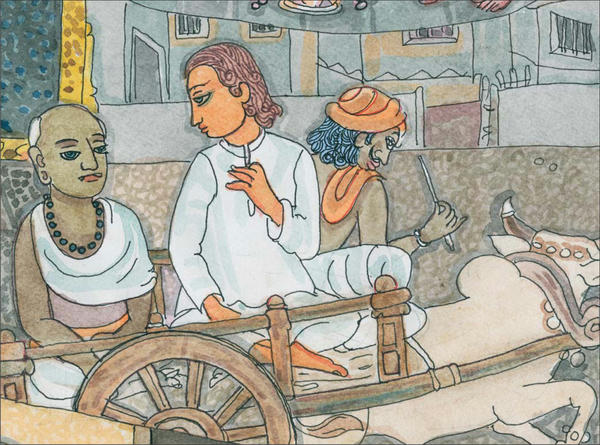
In May of 1949 the American seeker was taken to see Yogaswami for the first time. A bullock cart was hired for the journey to the great guru’s hermitage.
• • • • • • • • • • • • • • • • • • • • • • • •§
The home was on an unpaved road in the rural village of Alaveddy, in an area known for its agricultural bounty. There was no town there then, nor is one there now. The largest building, apart from the Ganesha temple 200 yards away, was a two-story shop across the street that would one day be Robert’s ashram. Most of the surrounding area was peppered with the white tropical homes common of this desert climate, with their mud walls, windows covered with iron bars and open-to-the-sky interior courtyards which received the welcome, if infrequent, rains right into the home. §
A few shops plied their wares down the road; a pen factory (if a cottage-industry-size business can be called that) was not far away, near a series of sheds where fifteen weavers at their hand looms wove loudly from dawn to dusk, making the khadi cloth that most Tamil men wore, 12-foot lengths of white cotton wrapped about the waist. The house was austere by Western standards, but immaculate, set in a three-acre compound full of coco palms, neem, amla trees and other edible species, surrounded by a natural fence of thorned bushes, and in a few places by woven palm fronds, called cadjan.§
Fifty feet from the kitchen was the family well, an open kinaru, as the Tamils call it. Stone walls defined the eight-foot-wide well below ground, and above there was no wall, just a paved circular platform on which bathers stood. Water was drawn by hand, using a wooden bucket attached to a rope, attached to the small end of an 18-foot-long, 1-foot-thick coconut log set on a fulcrum, the other end of which had a net of stones to provide the needed balance. For bathing, Robert learned to wrap himself discreetly, for there was no fence to provide privacy. Each member of the house took turns, twice daily, at the well, the women bathing in full dress.§
Meals were the central events of the day and took much of the women’s effort, cooked as they were on open fires fueled only by wood. If a visitor even smelled the food, it was incumbent on the family to invite him for the meal. The community here was overwhelmingly vegetarian, and the cuisine was remarkable in its variety. South Indian rice and curry evolved further over the centuries in Lanka, including the unique Sri Lankan red country rice with its distinctive odors and lighter-than-air grains. §
With no refrigerators, everything was bought and made fresh from the land; leftovers, along with the banana-leaf plate, were tossed over the fence for the cows to enjoy, eliminating much of the dishwashing. Nothing was wasted. When shopping, a family took its own basket to the market to gather the day’s vegetables, legumes, grains and fruits; there was no food packaging. Milk was drawn directly into the pot it would be boiled in. The culture was so remarkably self-sufficient and Earth-friendly, there was no trash can in the home, no weekly garbage pickup and no landfills. The rare foreign pen that had broken had to be individually buried in the compound.§
It was the first time I had been in an orthodox Hindu home. I was so at home there. It was wonderful. The northern part of Sri Lanka is quite different from the southern. It’s like being in a different country. The religion is Hindu. In southern Sri Lanka, the religion is Buddhism. The North is dry, arid and very flat, not lushly tropical like the South and the hill country. I felt immediately at home. We lived quite humbly, bathing at the well and using Coleman lanterns when the sun went down. We walked or took a bullock cart when traveling to the temple or the open air marketplace.§
Everybody was so simple there. They had no furniture in anybody’s home; everything was all on the floor. And even if people could afford furniture, they wouldn’t buy it because their opinion was that they would insult somebody who could not afford furniture. And since nobody used furniture anyway, they didn’t need it. And there was no electricity either in most areas. So everything was very, very natural. And the temple is the center of each small community.§
Taking our time, we visited fine temples of the area, the Ganesan temple, the Nallur Kandasamy Temple and many others. All the while I was absorbing the inner atmosphere and being blessed by the Gods themselves as electric vibrations would come forth from the temple and flow through my body. I felt wonderful. It was wonderful. I was there. I was expecting to become a Hindu, the peak experience of my life.§
Privacy inside was a new experience for him as well. There were no doors on the rooms, just simple curtains, and no one knocked before entering. He was deeply impressed that things regarded as personal in the West were part of the family here. His mail could be opened and read without the slightest sense of intrusion. The consciousness of shared existence was a revelation to him.§
The family loved their guest, and he adored them. They learned from one another and bridged their cultural differences. At one point, Robert sought more seclusion, and the family allowed him to stay for some weeks in a thatched hut about a quarter mile away. It sat in a sandy field, surrounded by nothing but sagebrush and coconut trees, but it did have a small well attached, and the aloneness there was conducive to his disciplines. §
He would visit the Kumbhalavalai Ganesha Temple in the early hours of dawn, walking the narrow dirt paths that weave the village together, then return for a day of solitude and meditation. Kandiah Chettiar would check on him regularly, constantly worrying about the youth who was a stranger to his land and its manners. They spoke often of the inner life. It was something Kandiah could not share with his family, even with his guru, for that was a formal relationship. Here he had a fellow seeker to talk with, and both enjoyed the hours spent in spiritual conversation. §
Meeting “the Old Beggar”
Robert felt so at home in this Saiva community, so at one with its culture, its people, its rich spirituality, that he wanted to formally unite with it.§
One day I said to him, “I want to become a Hindu. I feel like I am a Hindu already because that has been my training from a very young age up to this point, but how can you arrange it officially? Will you take me to a very pure priest, one who has Self Realization?” He responded, “There are no priests in our temples who have the realization of God of which you speak. Just wait. It will come. The time will come.” He was destined to take me to my guru, but was waiting for the right time, watching for the signs.§
Kandiah continued to play down the meeting. He would not let his American son, as he called him, go straightaway to Swami, but had him wait for the perfect moment. Finally, one day he announced, “It seems that today is a good day for you to meet Yogaswami.” He did not go himself, but sent his son, Vinayagamoorthy, giving him careful instructions as to how they should go and who should take them. §
That was May of 1949, an auspicious, festive time in Jaffna. Yogaswami’s birth was celebrated in that month. There is also a special Muruga festival during the period. In the South, Wesak, the anniversary of Buddha’s illumination, is celebrated, and mangoes, a fruit sacred to Lord Murugan and cherished by all, were ripening. §
They started on their way at about three o’clock in the afternoon. There was a breeze in the air that cooled them as they walked to the next village, Mallakam, to catch the bus to Jaffna. At about 3:30 they reached that village. A bus came fifteen minutes later. Shortly after five, they arrived in Jaffna and went straight to the house of Kumar Surian, a barrister who Kandiah said would take them to see Swami. The proctor was happy to accompany them, but entertained them first with tea and stringhoppers while his servant prepared the bullock cart. Fifteen minutes later they were off, leaving the house in a wagon drawn by two handsome white brahma bulls. §
The cart plodded first to Nallur Kandaswami Temple. Kumar suggested that they get down there and worship before going to see Swami. It was almost 6 o’clock, he said, and the puja would soon begin. They disembarked, washed mouth, feet and hands, and went inside the temple. In those days, devotees of the temple could worship closer to the sanctum than one can now. The three men stood just outside the sanctum for the ceremony, consumed in the intensity of the darshan. §
It was about 7pm when they arrived at Yogaswami’s hermitage. The sun had set, and a full moon illumined the landscape. The lamps were lit, and the evening had brought devotees to Swami. The atmosphere was electric—charged with the presence of the satguru. About fifteen people were sitting with him. No sooner had the screeching of the cart wheels stopped than Swami’s voice from the hut was heard loud and clear, “Come, come, come. I am waiting for you.” Vinayagamoorthy recalled: §
As soon as we opened the gate and entered the ashram, Yogaswami asked Robert in a loud voice, “Did you see me anywhere?” Robert replied, “Yes, at the Nallur Temple,” and the following conversation took place. Yogaswami: “You are in me.” Robert: “You are in me.” Yogaswami: “I am in you.” Robert: “I am in you.”§
The devotees present were astounded. No one had ever talked in such a way with Yogaswami since the days of Chellappaguru. Usually if he said to a devotee, “I am in you,” the person would respond humbly, “Yes, Swami.” Or he might begin singing a song that Swami had composed. No one ever responded the way Robert had. He spoke as confidently as Swami himself, and he echoed Swami’s very words. §
At that point Swami eased the intensity of the moment and asked his visitors to enter. “Come and sit with Jaffna’s old beggar.” Robert knew the protocol and once Swami was seated moved forward to prostrate. But Swami indicated he should not, and invited him to sit on a nearby mat that had been laid down for this unusual visitor. §
Yogaswami was in a jolly mood that night, smiling and laughing as people came before him. It felt like a special holiday. There were large bunches of grapes on a tray in front of him. He called to a devotee, Pundit A.V. Mylvaganam, and asked him to take them and make some juice for the three visitors. §
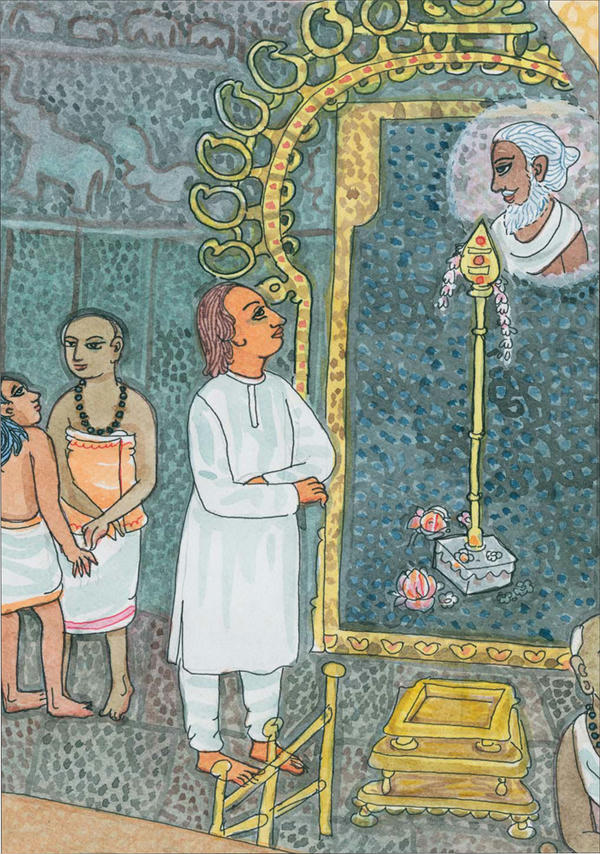
To prepare for meeting Yogaswami, Robert was taken to Nallur Temple to seek the blessings of Lord Murugan, enshrined as a vel. Standing before the darkened sanctum, he had his first vision of the man who would be his satguru.
• • • • • • • • • • • • • • • • • • • • • • • •§
While awaiting the refreshments, Yogaswami asked his guest if he had read Patanjali’s Yoga Sutras. In fact, he got the book down from his shelf, commenting that it was the only book he kept. Robert said yes, he had read it. In fact, it was the only book he had really studied during his early training. He had read and practiced it for years. Yogaswami tossed a few penetrating questions about the pithy classic. Robert answered quickly and clearly. Recounting this experience later, he said that the answers came immediately, not as an intellectual memory, but from within. §
Then Yogaswami asked about the difference between advaita and dvaita. Robert answered that both are true, depending on one’s perspective. Yogaswami smiled, obviously enjoying the way in which the disciple had grasped that it is not one and not two. Swami, well familiar with the controversy between the two schools of philosophy, was satisfied. Dr. S. Ramanathan later provided the following insights: §
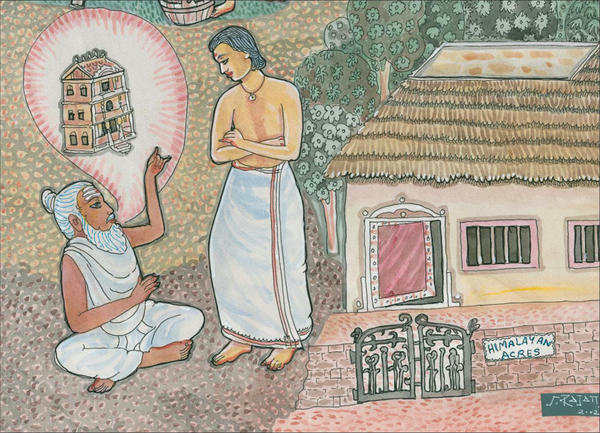
During their conversations, Robert shared that he had established a small ashram in the village of Alaveddy. Yogaswami predicted it would one day be a three-story building.
• • • • • • • • • • • • • • • • • • • • • • • •§
Swami once told me that the mahavakya “Aham Brahmasmi” is not correctly understood by people who criticize Advaita Vedanta. He had high regard for the Advaita Vedanta of Sri Shankaracharya as well as for the Siddhanta Shastras. One day when I was going to the ashram at Columbuthurai, I was thinking of the debate between Vedanta and Siddhanta. The minute Swami saw me he sang a line from the work of Tayumanavar: “We belong to the group of learned mystics who have understood the complete agreement and equality of Vedanta and Siddhanta.” Then he placed his hands on his chest to indicate that it was the firm truth.§
Their philosophical repartee lasted about twenty minutes. Finally the grape juice arrived and Yogaswami offered it to his guests. That ended all discussion for the evening. Swami told them to begin their trip home, as it was a long way. §
Taking Swami’s leave, they walked to the waiting bullock cart. The devotees, still entranced by the enigmatic encounter, also made their way off into the night. Kumar, the lawyer, an astute man, was impressed, and a little upset, too. He interrogated the guest, “Why did you tell Swami you saw him at Nallur Temple this evening? I was with you the whole time and I didn’t see him.” Robert replied, “I saw him in the inner sanctum during the puja. He was standing there, right in front of me.” With that, the lawyer grasped the mystical nature of the relationship between Yogaswami and Robert. §
Decades later, the American described his meetings with Yogaswami. §
One day, I was invited to go to Yogaswami. Jnanaguru Yoganathan, affectionately known by the people of the area as Yogaswami, was a magnificent man. No one approached him unless they were in the right mood. Some were literally afraid of him. When within the radius of him, one could feel the atmosphere scintillating. One felt electricity in the atmosphere. Devotees would prepare themselves on the inside so everything was all right before visiting this guru. Just to take him a little bit of fruit, they would sometimes prepare themselves for three or four days. If asked when they would be seeing the guru, they would say, “Well, I’m not quite ready yet to see Yogaswami today, maybe tomorrow.” Or, “I will go on a very auspicious day.” This was because they didn’t want him to look through them and point out something that they saw in themselves that they thought he might see. He always knew when people were coming to him before they arrived.§
My meeting with him was unusual because I was introduced, and he said, “Come on in and sit down.” Everybody else prostrated before him. In the Orient, devotees prostrate in front of a guru, placing the entire body face down on the floor. He said to me, “You come in and sit down. You don’t have to do that. You and I are one.”§
Then he started asking me the deepest of philosophical questions. I must have given the right answer each time; he seemed very pleased. As soon as he had asked the question, without hesitation I spoke the answer. Then he gave me the name I hold today, Subramuniya. “You are white; Subramuniya [Lord Muruga] is white,” he told me boldly. He was my guru, my master. Subra means “the light than emanates out from the central source.” It just emanates out. Muni means a silent teacher, and ya means restraint. Subramuniya means a self-restrained soul who remains silent or speaks out from intuition, one who speaks out from the inner sky.§
He showed me the book he had on Patanjali’s yoga aphorisms. I had studied Patanjali, too. We had just a wonderful, deep and inner meeting. He treated me more like a brother. This did not surprise me, though, because I was so far within and not in the consciousness of being surprised, but it surprised everybody else. He made me eat food with him, and we parted. Before leaving, I mentioned to my guru that I had established an ashram in nearby Alaveddy and would like to have his blessings. He said, “Fine, good, it will one day become a three-story building, and you are going around the world, and you will feed thousands of people. You are going to build palaces.”§
He began giving me many different kinds of instructions, such as “You will return to America, and you will roar. And when you come back here, nothing will be gained and nothing will be lost.” He said, “Now you go and teach the realizations that you have had.” I was used to being told what to do by my six teachers on the path, so I was happy to have this positive instruction. After I left my guru’s presence, everyone started relating to me differently.§
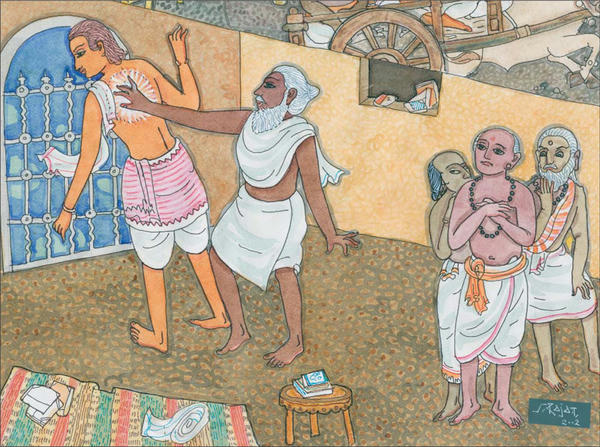
At the end of their third visit, Yogaswami followed his American visitor out to the gate. Coming up behind, he gave Subramuniya a powerful slap on the back that nearly toppled the taller youth. It was a spiritual initiation, one so potent that elders looking on stood perplexed.
• • • • • • • • • • • • • • • • • • • • • • • •§
On the second visit with my guru, we had a beautiful time together, just meditating and enjoying a beautiful flow. Many people came.§
On the third visit, we had a beautiful conversation about the path. Then, as I was leaving his ashram and he was seeing me out, he gave me the hardest slap on the back that I had ever felt from anybody. With all his might he reached out and cracked me on the spine between the shoulder blades. It was tremendous. I would have fallen on my face if I had not been so tall. Some of the Hindu devotees were startled, too, because that is one of the most powerful ordination initiations ever given. After this initiation, he gave me some powerful instructions…. With this diksha he sent me as a sannyasin to America. I was 22 at the time, and he was 77. §
The dozens of people at the hermitage that day began to regard the young American in a new light. Subramuniya later reflected:§
There are four ways that a guru will initiate or ordain. One is through talking, a very mild way. Another is by a look, and another is through thought. The most powerful initiation is through touch combined with the actual inner power, for through this contact, with intent, he begins to feed and transmit all of his inner knowing and inner power to the disciple. In this way, Yogaswami gave to me all his knowledge of how to be a guru. It later began to unfold within me from him, then from his guru and then from his guru’s guru. This is how the spiritual power in a line of gurus is transferred and increased.§
Of this, Vinayagamoorthy wrote:§
It is said that a guru initiates his disciple by one of the four ways—thought, word, look and touch. But, in Subramuniya’s case we find that our Yogaswami knew of Subramuniya’s presence at the Nallur Temple and gave darshan (thought); said, “You are in me. I am in you” (word); naturally looked at him (look); gave a blow on his back (touch) and hence showered and crowned him with all the blessings and power that has to be given by a guru to his disciple.§
Yogaswami’s giving Sri Subramuniya that resounding slap on the back surprised everyone present. They weren’t sure what it meant. Kandiah smiled when he heard about it, saying, “Now he has performed the coronation.” This was the young disciple’s ordination, which would later be understood as Yogaswami’s appointment of a successor. Justice of Peace Tiru S. Subramaniam witnessed the event, which he later described as “a transmission of Yogaswami’s samskaras, or vital divine spiritual energies.”§
Yogaswami advised his young initiate, “When you’re a guru, don’t be like an American mother.” Seeing his disciple puzzling over the meaning of his statement, he added, “You know, they wander about here and there while someone else takes care of the children. Stay in your ashram and be close to your students.” As they parted this time, devotees heard Yogaswami tell his shishya, “Whenever you want me, I will be with you.” §
After Subramuniya left, Yogaswami quickly changed the tone of the gathering, leaving them no room to wonder or talk about what had happened. “He must be a dancer,” he chortled, “He moves like a borzoi.” Kandiah Chettiar later wrote in a letter called “Meeting the Speaking God:”§
From that day onwards Sri Subramuniya appeared as reborn and the mental calmness was very clear and visible. He was at the early stages observed to be interested in art, dance, music and other activities. Even in these worldly activities, where he had to be in the company of women, he trained them to partake in such activities to pronounce the word “Aum,” which keeps humanity to have a control over the senses.§
Subramuniya recalled that when he went the fourth time he found Yogaswami sitting alone, meditating deeply. As he approached the doorway, Yogaswami opened his eyes and roared, “I’m not at home.” Startled, the youth turned to leave—but apparently not quickly enough, as Swami repeated, louder this time, “I am not at home!” The message was clear: their time together was finished; and the disciple left the hermitage for the last time. §
Back in Colombo
In 1949, Subramuniya teamed up with Kandiah Chettiar to form the Ceylon Bureau of World Affairs, whose motto was “East has met West and all that has transpired has been for the best.” They had also founded the Ananda Ashram. A Tamil-language newspaper wrote of such efforts in this report from May 22, 1949: §
Robert Hansen’s Visit to Jaffna. One of the officers of the American Asian Cultural Mission has been in Colombo for the last two years. His name is Robert Hansen. He visited Jaffna last Friday. This young lad, who is interested in the soul culture, is studying the secrets of Hindu religion and the methods of worship with great sincerity. He very much appreciates the artistic activities here and the dances of the East. A center, called the Ananda Ashram, has been established at Alaveddy in Jaffna, under the patronage of the American Asian Cultural Mission. This ashram will promote spiritual and social progress. Any religionist can be a member of this institution. Mr. C.K. Chettiar, who is a businessman, was instrumental in organizing the institution. His son, Mr. Vinayagamoorthy Chettiar, is working as the secretary. The first duty of the ashram is to spread universal love.”§
Subramuniya’s stay in Jaffna would continue for some weeks, but everyone knew he would return to Colombo. By September of 1949 he was dancing again in the capital and taking the reunited troupe into the Kandy hills to continue the cultural shows. But it was never the same. His time with Yogaswami and with the Chettiar family had transformed him.§
I filed papers to become a citizen of Sri Lanka after being initiated and then adopted into Chettiar’s family. I had burned all bridges of a career behind me and had nothing to go back to in the States. My visa was expiring, so I filed for citizenship. Chettiar took me into the office. I talked personally with the Prime Minister. Four months went by, and we didn’t hear anything from the office. §
A friend of Chettiar’s took us in to see about the status, and there the papers were, all by themselves on a shelf, unprocessed. That got back to Yogaswami, and he said, “Go build a bridge.” So, I packed up, leaving everything I had in a big trunk and left the keys with Dayananda. I took the boat back to the US. It was a rough ride, too. I passed through the Suez Canal and landed in Boston, then took a propeller plane from there to San Francisco at a cost of $80. The ship cost was $400, all paid for by my inheritance.§
Subramuniya’s ship back to the US traveled through Port Said on December 14, 1949, sailing across the Atlantic to arrive in Boston on December 29. §